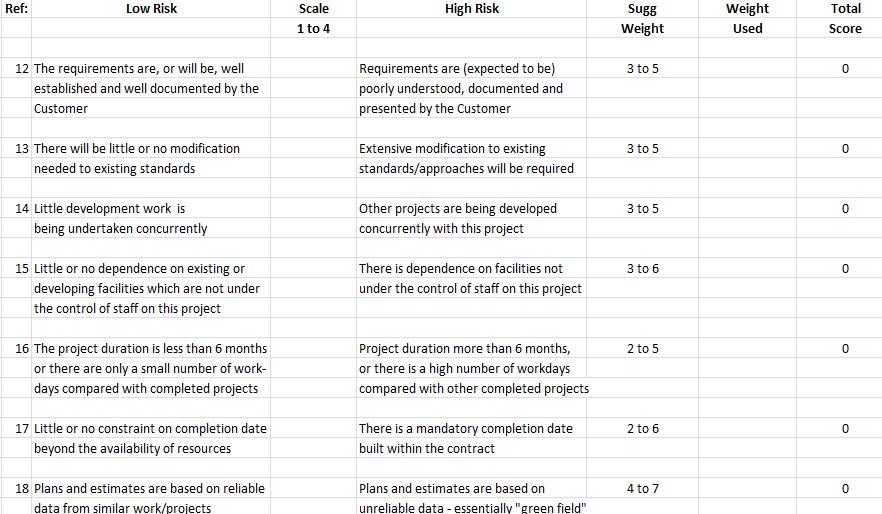Project Risk Assessment Form Template
Save, fill-In The Blanks, Print, Done!

Download Project Risk Assessment Form Template
Today: USD 2.49
Download It Now

Available premium file formats:
Microsoft Spreadsheet (.xls)- This Document Has Been Certified by a Professional
- 100% customizable
- This is a digital download (197.5 kB)
- Language: English
- You will receive a link to download the file as soon as your payment goes through.
- We recommend downloading this file onto your computer.
Looking for an easy-to-use Project Risk Assessment Form? What are the steps involved in writing a risk assessment? Our Project Risk Assessment Form is designed to help you quickly assess the risks associated with a project. It includes a comprehensive checklist of items and an easy-to-use scoring system. Download this form and get started today.
A Project Risk Assessment Form is a structured document or tool used by project managers and teams to identify, evaluate, prioritize, and manage risks associated with a specific project. It is an essential component of project risk management and helps ensure that potential risks are systematically analyzed and addressed throughout the project's lifecycle.
Here are the key elements typically included in a Project Risk Assessment Form:
- Project Information: This section includes basic project details such as the project name, description, start date, end date, and the names of project stakeholders.
- Risk Identification: This is where project team members brainstorm and list all potential risks that could impact the project. Risks can be categorized as internal (related to the project itself) or external (related to external factors such as market conditions or regulatory changes). Common risk categories might include scope, schedule, cost, technology, and more.
- Risk Description: Each identified risk is described in detail, including its potential impact on the project's objectives, its likelihood of occurrence, and any contributing factors or root causes.
- Risk Analysis: This involves assessing the severity or consequences of each risk and its likelihood of occurring. Typically, a numerical scale or a qualitative assessment (e.g., low, medium, high) is used to rank risks based on their potential impact and probability.
- Risk Prioritization: Risks are prioritized based on their analysis results. High-priority risks are those with the greatest potential impact and likelihood of occurrence and should receive more attention and resources in terms of mitigation and monitoring.
- Risk Mitigation: This section outlines specific strategies and actions to reduce or eliminate the identified risks. It includes plans for risk avoidance, risk transfer, risk reduction, and contingency plans if the risk materializes.
- Responsibility: Assign specific team members or stakeholders responsible for implementing and monitoring risk mitigation strategies.
- Monitoring and Review: Describe how the project team will continuously monitor and review the identified risks throughout the project's life cycle. This may include regular risk review meetings, status reports, and updates to the risk assessment form.
- Documentation: Ensure that all changes to the risk assessment, as well as any actions taken to address risks, are documented for future reference and for auditing purposes.
- Sign-off: Obtain approval and sign-off from relevant stakeholders, including the project sponsor and senior management, to acknowledge their awareness and acceptance of the identified risks and the proposed mitigation strategies.
Project Risk Assessment Forms are dynamic documents that evolve as the project progresses. They provide a structured framework for proactive risk management and help project teams stay informed and prepared to deal with potential challenges. Regularly updating and revisiting the form ensures that new risks are identified and that mitigation strategies remain relevant throughout the project's life cycle.
We provide a thorough and professional Risk Assessment Template in Excel, also known as: 'Project Risk Assessment Template'. The form contains 37 project management questions, with a variation of 1 to 4 and also a suggested 'weight factor' to calculate your risks.
The risk factors, i.e. those which affect the probability that the project will be completed on time and within the agreed contract/budget, and will deliver a quality-compliant End Product, arise from the following six sources:
- Project Management
- Project Staff
- Nature Of Project
- Maturity of the Organisation (Internal and Third Party Suppliers)
- Customer and Contract
- Third-Party Supplier
The risks associated with each of these elements are itemized and estimated below in the form of statements typifying low and high risk, on either side of a scale of 0.1 to 4.0. The assessed risk under column (b) has been multiplied by the weighting factor inserted in column (e) to provide a total score for each risk factor identified. On a separate Excel tab, you can find the Risk Analysis sheet that shows the "Consequences" and "Likelihood".
Our project management templates in Excel are all screened by project professionals. Download this project risk assessment template to professionalize your way of communication and to save time, costs, or effort!
Download this Project Risk Assessment template Excel template and after downloading you can craft and customize every detail and its appearance very quickly.
Check this link for more Risk Assessment Templates!
DISCLAIMER
Nothing on this site shall be considered legal advice and no attorney-client relationship is established.
Leave a Reply. If you have any questions or remarks, feel free to post them below.
Risk Assessment Template
Check out these Risk Management templates and find one that meets your company or industry needs!
Read moreRelated templates
Latest templates
Latest topics
- GDPR Compliance Templates
What do you need to become GDPR compliant? Are you looking for useful GDPR document templates to make you compliant? All these compliance documents will be available to download instantly... - Google Docs Templates
How to create documents in Google Docs? We provide Google Docs compatible template and these are the reasons why it's useful to work with Google Docs... - IT Security Standards Kit
What are IT Security Standards? Check out our collection of this newly updated IT Security Kit Standard templates, including policies, controls, processes, checklists, procedures and other documents. - Letter Format
How to format a letter? Here is a brief overview of common letter formats and templates in USA and UK and get inspirited immediately! - Google Sheets Templates
How to work with Google Sheets templates? Where to download useful Google Sheets templates? Check out our samples here.
cheese
